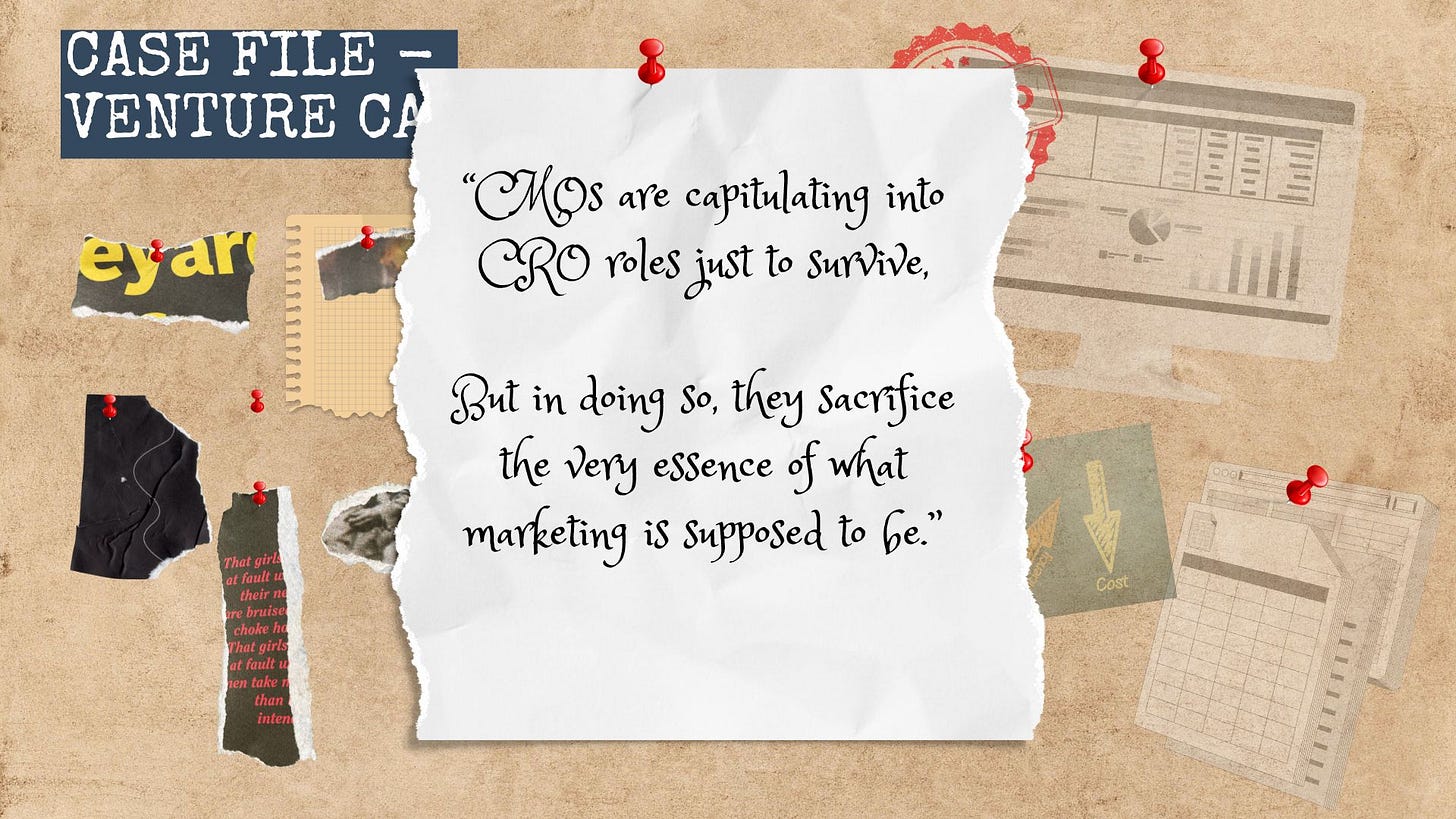Chapter 4: Scene Two. Ronnie, The Chief Revenue Officer.
The Boardroom, Later That Day…
Ivor hadn’t left his seat.
He sat in the same chair, the same stale boardroom air pressing down on his shoulders. The light outside had shifted, casting longer shadows across the room.
Ronnie, the CRO, hadn’t moved either—still leaning back, still wearing that unshakable smirk. But something had changed. The bravado had begun to crack. Because, while Exhibit A and B had exposed the structures that replaced strategy with sales targets, the next set of files were more personal. More damning.
They would reveal what Ronnie truly took from Mary Marketing.
Her strategic influence.
Her power.
And, perhaps most revealing—her pay cheque.
Ivor flipped to the next tab in the file.
“Let’s go deeper,” he said.
Exhibit C: The CRO’s Strategic Blindspot
Behind Ronnie’s polished confidence was a dangerous blind spot: a refusal to think long-term.
Marketing leaders who once shaped strategy, built brands, and drove customer-centric growth were now relegated to sales enablement roles—tasked with designing playbooks, onboarding decks, and managing tools purchased on someone else’s budget.
Anonymous Report from a frustrated VP of Marketing:
“The CRO buys a shiny new sales tech tool on a whim, sticks it on the marketing budget, then tells us to implement it and train the team. It’s not enablement—it’s chaos. And when it doesn’t work? We’re the ones who get blamed.”
Sales enablement had become a code word for “make up for the CRO’s lack of process, leadership, and accountability.”
In truth, many CROs loved the chase but avoided the discipline of team leadership. They liked being the hero who swooped in to close deals but rarely built robust, scalable systems that didn’t rely on adrenaline and luck.
And yet, they held all the power.
Exhibit D: The Power Grab
The evidence kept piling up. Ronnie’s rise wasn’t accidental, it was systemic.
Stat 1: The Rise of the CRO vs. CMO
Over the past five years, the number of CRO roles in B2B organisations has increased by 75%, while CMO roles have declined by 15% in the same period.
In some industries like SaaS, more companies now employ a CRO than a CMO, according to a 2024 Forrester executive trend report.
Stat 2: Reporting Lines
In over 60% of B2B tech companies, the CMO now reports to the CRO, not the CEO (LinkedIn Talent Insights, 2023), further eroding strategic independence and influence.
Once positioned as peers to the CEO, CMOs were now reporting into CROs or being replaced entirely by “growth leads.”
Stat 3: Salary Disparity
The average UK CRO salary is now £215,000, with equity and bonuses often totalling £400k+ packages.
In contrast, CMO salaries have plateaued or declined, averaging £140,000–£160,000, with significantly fewer equity opportunities (Marketing Week Salary Survey 2024).
Many had seen their salaries stagnate or decline.
Why? Because while the CMO title was being diluted and dismantled, the CRO seat came with power, prestige—and a much higher pay packet.
Ivor raised an eyebrow.
“Mary had all the responsibility… but none of the reward?”
Ronnie said nothing.
The silence was telling. The shift wasn’t just about job titles, it was about money and influence.
The perception was clear: sales close deals, and therefore, sales hold all the organisational value.
Exhibit E: The Capitulation of the CMO
Ronnie hadn’t just taken control. Marketers in the city were handing the power over willingly, with a secret handshake.
Some CMOs had seen the writing on the wall. They dropped the “Marketing” badge and rebranded themselves as CROs. A promotion in name, perhaps—but a betrayal of marketing’s long-term role in the business.
Ivor had seen the data in an earlier file.
Over the past 18 months, dozens of senior marketers had pivoted into revenue roles, not because they wanted to, but because it was the only way to keep a seat at the table and a salary that remunerated their experience and skillset.
But it came at a cost.
“CMOs are capitulating into CRO roles just to survive,” Ivor noted in his file. “But in doing so, they sacrifice the very essence of what marketing is supposed to be.”
Ronnie adjusted his cufflinks. “Look,” he said. “Sales brings in the revenue. We know the customer. We close the deals. Marketing? They support.”
Ivor raised an eyebrow. “Do they? Or have they simply surrendered?”
And then came the gender imbalance.
Exhibit F: The Gender Power Shift
Marketing had long been a profession where women had thrived. 52% of CMOs are women.
And, the data revealed something even more curious.
CMO roles have historically been one of the few C-suite positions with near gender parity.
But CRO roles? Only 12% are held by women.
And now, as marketing shifted under Ronnie’s remit, strategic power had quietly moved from one of the most gender-balanced roles to one of the least.
Quote from an anonymous CMO:
“We finally earned our seat. And now they’re replacing the table.”
So, as the CMO had been carved up and replaced by revenue leadership, power had quietly been transferred away from Mary and the other women.
“We don’t just have a title crisis”, Ivor noted grimly. “We have a gendered power shift disguised as an organisational restructure.”
Ivor looked up from his file.
Ronnie still wore that confident smirk. But even he looked a little rattled as the detective laid out the final exhibit.
Exhibit G: The Pipeline Delusion
Under Ronnie’s watch, Mary had been forced to speak in acronyms.
MQLs. SQLs. SALs. ACV. ARR. CAC.
But somewhere along the way, her actual value had been forgotten.
Brand had become a luxury as Victor, Ronnie, and the CEE conspired.
Customer insight was replaced by win/loss reports.
Innovation was buried under dashboard reports.
Mary had tried to warn them. But no one was listening.
And now she was on the floor.
Ivor stood. He didn’t need to say anything else.
Ronnie may have claimed innocence. But his fingerprints were everywhere.
Ronnie hadn’t just taken over marketing. He had absorbed it—redefined strategy, pushed revenue immediacy, sidelined long-term brand investments, and shifted metrics to justify the takeover.
Ivor still wasn’t sure if Ronnie had pulled the trigger on Mary Marketing. But he felt that he was somehow involved in the drama unfolding around him.
Ronnie had made Mary feel that if she wasn’t driving revenue this quarter, she was failing.
He turned her from a strategic partner into a sales assistant.
He made her believe the only way to survive was to become him.
And when she finally collapsed from the weight of it all?
He moved on to his next pipeline target - without looking back.
“I don’t know what everyone’s so upset about,” Ronnie shrugged. “Marketing should support sales. That’s their job.”
The room had fallen quiet.
The smirk had faded from Ronnie’s face. Even he knew the weight of what had just been revealed.
Mary had been unravelled - one MQL at a time, one sales enablement deck at a time, one pipeline review at a time.
Her influence? Erased. Her purpose? Diminished. Her power? Replaced.
And now, as Ivor gathered his files and turned the page, he knew the investigation was far from over.
Ivor quietly closed the file.
The case was getting darker by the day.
And tomorrow? He’d turn his attention to the CEO.
To be continued……
Lost Influence? It’s Time to Fight Back.
If Mary’s story feels a little too familiar…
If your role has been diluted, demoted, or absorbed under revenue targets…
If you’re constantly justifying your existence while your influence quietly disappears...
Then it’s time to take it back.
Join me on 9th April for a free virtual Open Day where I’ll walk through the 10-week Influential Marketing Leader Accelerator — a proven programme to help marketers reclaim their authority, secure a seat at the table and lead marketing with credibility and confidence.
Programme starts 29th April.
Built for marketers who are done playing small.
Save your spot for the Open Day now









